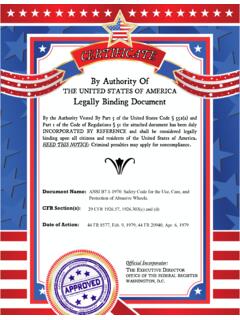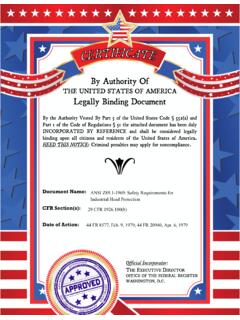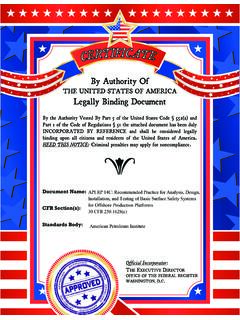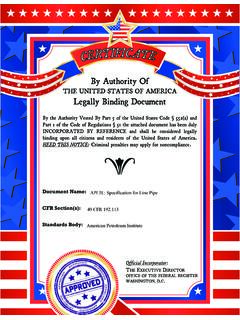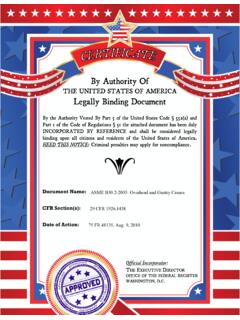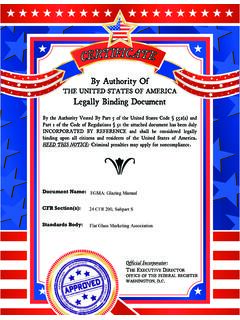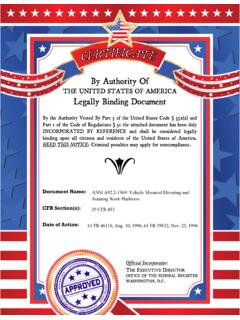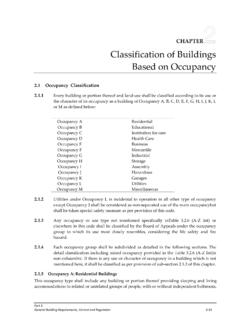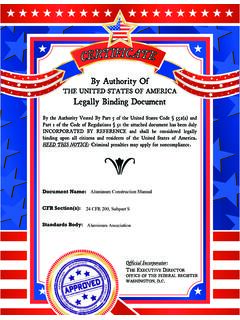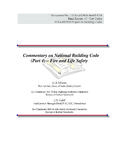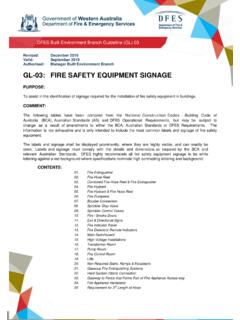Transcription of IS 1644 (1988): Code of practice for fire safety of ...
1 Disclosure to Promote the Right To InformationWhereas the Parliament of India has set out to provide a practical regime of right to information for citizens to secure access to information under the control of public authorities, in order to promote transparency and accountability in the working of every public authority, and whereas the attached publication of the Bureau of Indian Standards is of particular interest to the public, particularly disadvantaged communities and those engaged in the pursuit of education and knowledge, the attached public safety standard is made available to promote the timely dissemination of this information in an accurate manner to the public. ! $ ' + - Satyanarayan Gangaram Pitroda Invent a New India Using Knowledge 0 1 ' 5 Jawaharlal Nehru Step Out From the Old to the New 1 + , 1 + Mazdoor Kisan Shakti Sangathan The Right to Information, The Right to Live !
2 > 0 B Bhart hari N ti atakam Knowledge is such a treasure which cannot be stolen Invent a New India Using Knowledge IS 1644 (1988): code of practice for fire safety ofbuildings (general): Exit requirements and personal hazard[CED 36: fire safety ]IS : 1644 - 1888 Indian Standard code OF practice FOR. fire safety OF BUILDINGS ( GENERAL ): EXIT REQUIREMENTS AND PERSONAL HAZARD ( First Revision ) ~- First Reprint JANUARY lW6 UDC : 692 622 I-I @ Copyrrgh I988 BUREAU OF INDIAN STANDARDS MANAK BHAVAN, 9 BAHADUR SHAH ZAFAR MARG NEW DELHI 110002 or5 h?cmher I968 IS : 1644 - 1988 Indian Standard code OF practice fire safety OF BUILDINGS FOR ( GENERAL ): EXIT REQUIREMENTS AND PERSONAL HAZARD ( First Revision ) 0. FOREWORD This Indian Standard ( First Revision ) was adopted by the Bureau of Indian Standards on 16 May 1988, after the draft finalized by the fire safety Sectional Committee had been.
3 Approved by the Civil Engineering Division Council. Indian Standards relating to fire safety of buildings have been formulated covering general principles and fire grading, details of construction, exposure hazard and exit requirements. This standard covering the last aspect was formulated in 1960. In the past 25 years, useful data has been made available by the research institutes of this country as well as from other advanced countries like USA, UK, Canada, etc. The pro- vision in this revision has, therefore, been made based on the data adopted by these countries, and therefore, have been completed modified. The exit requirements and personal hazard dealt with in this standard is considered as at least of equal importance to all other aspects; in fact in most cases, it is paramount because of the density of population associated with parti- cular occupancy; an example is that of a cinema or similar densely occupied building when con- trasted with a godown of similar occupancy.
4 Density of population varies from one building to another and also in the same building from, time to time; one example is that of a large general or mixed bazar, emporium or stores where a great variety of goods are displayed for sale; and at certain periods may be offered at special attractive bargain prices, with the result that normal population will be rapidly exceeded, more so during peak shopping hours when an outbreak of fire would cause considerable con- fusio?, poss_ibly panic; therefore, the closet attention to design and maintenance of escape routes including any staircases, cannot be over- emphasized. Likewise special consideration. is essential to arrangement of display of any highly flammable articles or materials for sale in such risks because of the danger normal escape routes being made unsafe or altogether useless. It would be neither possible nor advisable to rely on electrical or mechanical devices, such as lifts for moving the population of various floors to a place of safety because of the probability of fire rendering these devices inoperative.
5 There- fore, staircases with associated escape routes become all important and staircases considered in this code are the means of communication in an up and down direction of a building and serve not only as escape routes for occupants but also afford a direct means of access to the source of fire by the fire fighting -staff. In fact, staircase landings of buildings which present a serious hazard are required to have fire fighting equip- ment mounted thereon comprising hydrant stand, pipes and accessories. For the purpose of d!ciding whether a parti- cular requirement of this standard is complied with, the final value, observed or calculated, expressing the result of a lest or analysis, shall be rounded off in accordance with IS : 2-1960*. The number of significant places retained in the rounded off value should be the same as that of the specified value in this standard.
6 *Rules for rounding off numerical values ( revised ). 1. SCOPE a building when on fire is vital and all routes This standard covers requirements regarding should be ,constructed to ensure that the popu- fire safety Of buildings with respect t0 exit require- lation reaches a place of safety in the shortest ments and personal hazard. period of time without undue hindrance by smoke, fumes, debris and the like. 2. EXIT REQUIREMENTS Every building meant for human occupancy Ample provision for escape of population of should be provided with exits sul%cient to permit 1 IS : 1644 - 1988 safe escape of occupants, in case of fire or other emergency. Types of Exits An exit may be a doorway, a corridor or pnssagewny(s) to an internal staircase, or external staircusc, or to a verandah or terr:&s) which have ~CCCSS to the street, or roof Of a building, or ;I rcfugc are& An exit may also include a horizontal exit leading to an adjoining building at the same level.
7 Lifts and escalators should not be con- sidered as exits. General In every building, exits should comply with the minimum requircmwts except those not accessible for general public USC. All exits should be free of obstructions. No building should SO altered as to reduce the number, width or protection of exits to less than that required. Exits should be clearly visible and the routes to reach the exit should be clearly marked and sign posted to guide the population of the floor concerned. Signs should be painted with illuminated paint. NOTE -This provision not apply to A-2 and 2;45;ccupancies up to 15 m In height ( and .. Where necessary, adequate and reliable illumination should be provided for exits. fire check doors 1 WC IS : 3614 ( Part 1 )-1966* 1 should at appropriate places along the escape routes to prevent spread of fire and smoke and particularly at the entrance to lifts and stairs where a funnel or flue effect may be created, including an upward spread of fire .)
8 All exits should provide continuous means of access to the exterior of a building or to an exterior open space leading to a street, Exits should be so arranged that they may be reached without passing through another occupied unit. Occupant Load - For determining the exits requirement, the number of persons within any floor area or the occupant load should be based on the actual number of occupants, but in no case less than that specified in Table 1. hfcza/liuc and Bdcotl~~ - The occupant load of a mezzanine floor and balcony discharg- ing to a floor below should be added to that floor occupancy load thus established. *Specification for fire -check doors: Part I plate, nletal coxred and rolling ry~c. Cl. 10 1. 2. 3. 4. 5. 6. 7. 8. TABLE 1 OCCUPANT LOAD ( Clause ) GlrolJl OF OC c liP.\NCY Ot~c~uraw LOAD, FLOOR ( see IS : 1641-1988; ) ARE_\ IN m /PEltSox Residential (A) Educational (B) 4 Institutional (C) 1st Assembly: (D) a) With fixed or loose seats and dance floors 0 b) Without seating facilities including dining rooms 1 5$ Mercantile: (F) a) street floor and sales basement 3 b) upper salt floors Business and industrial I E and G ) 10 Storage (H) 30 Hazardous (J) 10 * code of practice for the safety of buildings (general ): General principles of fire grading and classifications ( jrst revision ).
9 - _ _ *Occupant load in dormitory portions of homes for the aged, orphanages, insane asylums etc, where sleeping accommodation is provided, should be cal- culated at not less than m* gross floor area/person. fThe gross floor area should include, in addition to the main assembly room or space, any occupied connecting room or space in the same storey or in the storeys above or below where entrance is common to such rooms and spaces and they are available for use by the occupants of the assembly place, No deductions should be made in the gross area for corridors, closets or other subdivisions; the area should include all space serving the particular assembly occupancy. Capacity of Exits The unit of exit width, used to measure the capacity of any exit, should be 50 cm. A clear width of 25 cm should be counted as an addi- tional half unit. Clear widths less than 25 cm should not be counted for exit width.
10 Occupants per unit exit width should be in accordance with Table 2. Horizontal Esit Allo~~~orzcc - When hori- zontal exit is provided in buildings of mercantile, storage, industrial, business and assembly OCCU- panties, the capacity per store) per unit width of exit of stairways in Table 2 m:~y be increased by 50 percent; and in buildings of institutional occupancy, it may be increased by 100 percent. Arrangement of Exits Exits should be so located that the travel distance on floor should not exceed the distance given in Table 3. The travel distance to an exit from the dead end of a corridor should not exceed half the distance specilicd in Table 3. CSCL ~I in cdncational, TABLE 2 OCCUPANTS PER UNIT EXIT WIDTH SL No. (1) 1. 2. 3. 4. 5. 6. 7. 8. 9. ( Clauses and ) GROUP OF NUMBEROF &CUP ANCY OCCUPANTS ( See IS : 1641-1988* )r-----h----~ Stairways Ramps Doors (2) (3) (4) (5) Residential ( A ) 25 50 75 Educational ( B ) 25 50 75 Institutional ( C ) 25 50 75 Assembly (D ) 40 50 60 Business (E) 50 60 75 Mercantile ( F) 50 60 75 Industrial ( G ) 50 60 75 Storage (H) 50 60 75 Hazardous ( J ) 25 30 40 * code of practice for safety of buildings ( general ): General principles of fire grading and classification (first revision ).
